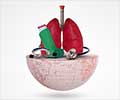-
Most consensus guidelines recommend that blood pressure not be treated in the patient with acute stroke unless the hypertension is extreme, as it is in hypertensive excephalopathy. It has been suggested that antihypertensive therapy be withheld for at least 10 days after a thromboembolic stroke unless the patient has cardiac failure, aortic dissection, or a diastolic BP above 120 mmHg and/or a systolic BP above 220 mmHg.
-
The optimal therapy of hypertension in patients with cerebral bleeding is not clear. In those with intracerebral hemorrhage, intravenous nitroprusside, nicardipine, or labetalol should be given if the systolic pressure is above 170 mmHg. The goal in this setting is to maintain the systolic pressure between 140 and 160 mmHg and to carefully monitor the patient for signs of cerebral hypoperfusion induced by the fall in blood pressure.
Antihypertensive therapy is generally withheld following a subarachnoid hemorrhage in the absence of a severe elevation in blood pressure because of concern about cerebral ischemia and the frequent compensatory nature of acute hypertension. The patients cognitive status may be a useful guide, if the patient is alert, then CPP is adequate and lowering the blood pressure may decrease the risk of rerupture. In contrast, antihypertensive therapy is generally withheld following a subarachnoid hemorrhage in those with a severely impaired level of consciousness since the impairment may be due to a reduced CPP.
A separate issue in patients with SAH is the administration of nimodipine, 60 mg every four hours by mouth or nasogastric tube. When started within four days of the event, nimodipine appears to reduce cerebral ischemia by decreasing vasospasm and may protect ischemic nerve cells against the damaging influx of calcium.
Breathing - Patients with increased ICP due to hemorrhage, vertebrobasilar ischemia, or bihemispheric ischemia can present with a decreased respiratory drive or muscular airway obstruction. Hypoventilation, with a resulting increase in carbondiozide, may lead to cerebral vasodilation which further elevates ICP.
Intubation may be necessary to restore adequate ventilation and to protect this airway, this is especially important in the present of vomiting, which occurs commonly with increased ICP, vertebrobasilar ischemia, and intracranial hemorrhage. Patients with adequate ventilation should have the oxygen saturation monitored, oxygen can be delivered by nasal cannula or face mask as needed.
Fever - Fever has special significance in patients presenting with acute neurlogical deterioration. Both problems may occur in patients with a primary central nervous system infection such as meningitis, subdural empyema, brain abscess, and infective endocarditis. These conditions need to be excluded as the etiology of fever.
Other considerations - The history and physical examination should be used to distinguish between other disorders in the differential diagnosis of brain ischemia. As examples, seizures, syncope, migraine, and hypoglycemia can mimic acute ischmia. The most difficult cases involve patients with focal signs and altered level of consciousness. It is important to ask the patient or a relative whether the patient takes insulin or oral hypoglycemic agents, has a history of a seizure disorder or drug overdose or abuse, medications on admission, recent trauma, or hysteria.
The physical examination should include careful evaluation of the neck and retroorbital regions for vascular bruits, and palpation of pulses in the neck, arms, and legs to assess for their absence, asymmetry, or irregular rate. The heart should be auscultated for murmurs.
The skin should be examined for signs of endocarditis, cholesterol emboli, purpura, or ecchymoses. The fundoscopic examination may be helpful if there are cholesterol emboli or papilledema. The head should be examined for signs of trauma. A tongue laceration may occur with tongue biting during a seziure.
The neck should be immobilized until evaluated radiographically for evidence of serious trauma if there is a report or suspicion of a fall. The chest x-ray is occasionally helpful if it shows a widened mediastinum associated with aortic dissection, cardiomegaly, or metastases. Examination of the extremities is important to detect deep vein thrombosis which can cause systemic embolization in patients with a patent foramen ovale.




